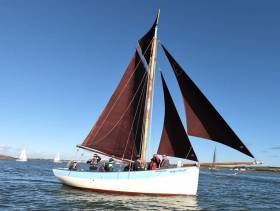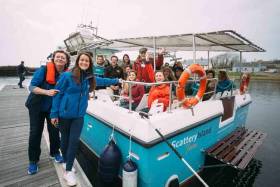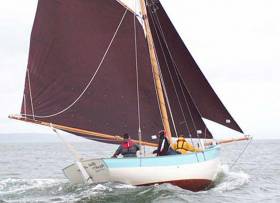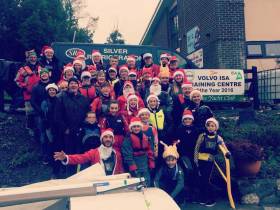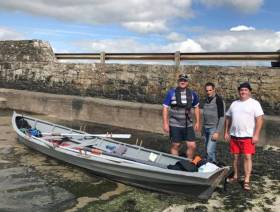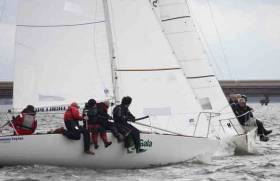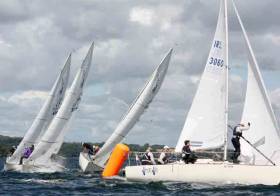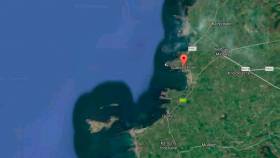Displaying items by tag: Shannon Estuary
Tralee Bay Sailing Club J24 Leads Spinnaker Class of Royal Western Yacht Club October Series
All changed at the top of the leaderboard of the Combined Club October Series being hosted by the Royal Western Yacht Club of Ireland on the Shannon Estuary.
Last Sunday the 21st of October, the fleet of twenty-six boats were met by a moderate northwesterly breeze which was building as they left the safe haven of Kilrush Marina.
Race officer Peter Moore from Tralee Bay Sailing Club set up a windward/leeward course for race one for the Spinnaker fleet, and a triangular course for race one for the Non-Spinnaker fleet. With the wind building further to 17 - 20 knots for the second race, for the Spinnaker fleet, the race officer decided to run an Olympic type course which was greeted with smiles all round with some very fast reaching legs.
"Race three for the Spinnaker fleet was a long coastal race"
Race three for the Spinnaker fleet was a long coastal race with the wind now in excess of 20kts finishing at Cappa Pier a short distance from Kilrush Marina. Race two for the Non-Spinnaker fleet the race officer set a long coastal race and again finishing at Cappa Pier.
Overall, leading the Non-Spinnaker Class is local sailor Darin Mc Gibney on his Beneteau 26 Jack Sparrow, ahead of local club member’s Gerry Cusack's GK 24 Mojo and Fintan Keating's Hallberg Rassy Passade in third.
Overall, leading the Spinnaker Class is Tralee Bay Sailing Club sailor Tadgh O'Loinsigh on his J24 Janx Spirit, with local club Rob Allen's Corby 25 Smile in second and Foynes Yacht Club sailor Simon McGibney with his J24 Lady J in third.
With one more days racing to go on Saturday 27th October it is all still to play for the top positions. Results are here
Shannon Estuary Cutter 'Sally O'Keeffe' Leads Non-Spinnaker Class in Combined Clubs October Series in Kilrush
The largest fleet to have gathered for an October Series along the west coast in a number of years came together this Sunday on the Shannon Estuary in the Combined Clubs October Series being hosted by the Royal Western Yacht Club of Ireland and sponsored by Kilrush Marina, Shannon Ferries, Clifford’s Cash & Carry and Aster Yachting.
The opening races last weekend were cancelled due to the weather but the sunshine and steady winds today made up for it in droves.
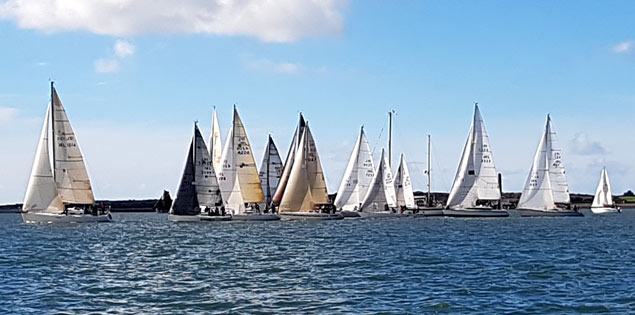 Part of the big fleet on the Shannon estuary for Sunday's October series at Kilrush
Part of the big fleet on the Shannon estuary for Sunday's October series at Kilrush
With 34 provisional entries, 23 boats sailed yesterday under the guidance of race officer Peter Moore from Tralee Bay Sailing Club. Three races were sailed for the spinnaker fleet with two races for non-spinnaker.
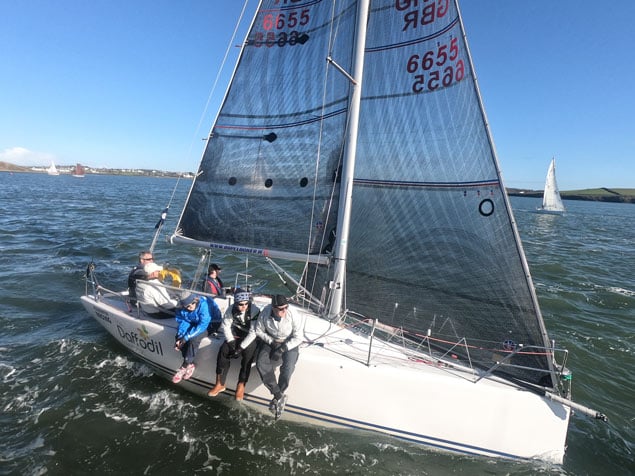 GBR6655 Daffodil Stonehaven Racing, a Corby 25 from the Royal Western Yacht Club Of Ireland
GBR6655 Daffodil Stonehaven Racing, a Corby 25 from the Royal Western Yacht Club Of Ireland
In the spinnaker class, the J24’s and Corby 25’s had it all their own way in a light to moderate southerly breeze. It was smiles all round for Rob Allen & crew in their Corby 25 winning race one with Simon McGibney’s J24 Lady J winning race two and Diarmuid Donovan sailing Peter Clifford’s J24 Gala Racing winning race three.
In the Non-Spinnaker division, it was boat builder Steve Morris with his traditional Shannon Estuary Cutter, Sally O’Keeffe, taking the honours in race one and local Darin McGibney on Jacks Sparrow winning race two.
Results are here
New 70 Passenger Ferry to Increase Visitors to Scattery Island & Boost Shannon Estuary Tourism
Six times as many tourists can now experience the hidden gem that is Scattery Island as Scattery Island Tours has secured a new 70 passenger ship for its daily trips to the monastic island.
Following on the success of its first season which saw a significant growth in visitor numbers, the company has invested in a larger ferry, having run a 12 passenger boat last year.
The new catamaran ferry, named "An Breandàn" represents a further investment in tourism in West Clare and reflects the growing interest in Island visits by both domestic and international tourists.
Scattery Island Tours was founded by Irene Hamilton in May 2017. Ms. Hamilton has close ties to the island as her father, Brendan Griffin was born and grew up there.
This emerging new tourist destination saw over 300% growth in visitor numbers last year and following its recent award as Ireland's European Destination of Excellence for 2017, the numbers are expected to continue to grow significantly over the coming years.
"Six times as many tourists can now experience the hidden gem that is Scattery Island"
The island is now ranked at No. 4 on "Trip Advisors Top Things To Do" in Co. Clare, sitting just behind Clare's prestigious Cliff's of Moher and Kilkee cliffs.
Last week, the new ship had its inaugural sailing to the island with representatives from Fàilte Ireland and a group of International Tour Operators.
Commenting on the new vessel, Irene Hamilton said "This new ferry will ensure that we can manage growing visitor numbers over the coming years and continue to position Kilrush and West Clare as a family friendly tourist destination, for both domestic and international tourists, further enhancing the development of the local economy. The vessel was partially funded by the LEADER grant tourism programme and we are very grateful for the support received from LEADER aided by the Clare Local Development Company (CLDC)".
"The new ferry is also designed to facilitate wheelchairs and Kilrush Marina offers full wheelchair access to the vessel for sailing departing from there. The company plan to develop a range of disability cruise options around Scattery island later this season" she added.
Minister of State for Trade, Employment, Business, EU Digital Single Market & Data Protection Pat Breen TD congratulated Scattery Island Tours on its success and paid tribute to the hard work of Ms Hamilton and her team in bringing one of Clare’s hidden tourism gems to international attention.
“Tourism had another record year in 2017 and is worth about €8.9 billion to Ireland – approximately 4% of GNP. I am delighted therefore to see a sustainable tourism business like Scattery Island Tours continue to grow and develop in west Clare. Businesses like this are the back bone of our rural economy. I wish Irene and the team all the very best as they voyage into what I am sure will be another successful tourism season on board the new 70 passenger ship.”
Scattery Island will commence its scheduled service to the island from Sunday April 29th and full details on the summer schedule can be found on their website here
Shannon Estuary Cutter Sally O’Keeffe Brings Focus to Loop Head Peninsula
Though it may not look it on a map which emphasises the extensive low water limits, at high water the Loop Head Peninsula in southwest County Clare is almost an island writes W M Nixon.
Only a couple of small roads lead into it from the main road between Kilrush and Kilkee, and once you’re into the Loop, you’re in a different country, a distinctive place with its own strong sense of identity.
It was here in Querrin that a voluntary group got together some years ago to build a boat to commemorate the small Shannon sailing hookers which were once the Loop Head Peninsula’s most important transport link for goods coming down the long estuary from Limerick.
 Loop Head Peninsula – a world apart with Carrigaholt at its heart
Loop Head Peninsula – a world apart with Carrigaholt at its heart
This local community group only had some ancient photos and sketches - and some vague old memories - to go by. But, guided by shipwright Steve Morris of Kilrush, they had naval architect Myles Stapleton of Malahide to bring his considerable talents to the task, and he created a wonderfully characterful 25-footer which looks good from any angle, sails well too, and can carry significant numbers to avail of Seol Sionna’s enthusiasm for spreading seagoing awareness. They’ve fresh plans afoot for 2018, and have sent us this cheerful message:
“Sally O’Keeffe, the traditional wooden sail training vessel based on the Shannon Estuary, is currently gearing up for her seventh season on the ocean, and is putting a shout out to any and all who would wish to sail on her.
The 25-foot gaff rigged cutter was built by community group “Seol Sionna” under the guidance and tuition of local professional shipwright Steve Morris from plans drawn up by naval architect Myles Stapleton. Launched in Querrin in 2012 just 200 metres from where she was built, this craft has become one of the busiest and most capable sailing vessels on the Estuary.
 The design of Sally O’Keeffe was neatly judged to provide the maximum on-board space Photo: W M Nixon
The design of Sally O’Keeffe was neatly judged to provide the maximum on-board space Photo: W M Nixon
Seol Sionna offer a “traditional seafaring skills” course on board Sally O’Keeffe each summer, taking participants through all stages of sailing to competent crew level. This is hands-on training - there are no winches or clutches, and the only buttons onboard are the chocolate ones that the skippers love! The atmosphere is fun and relaxed, but with a strong emphasis on safety.
On top of training, regular weekly sailing trips are made to various regions on the glorious estuary, picnics/walks/ birdwatching to Scattery Island, a jaunt to Carrigaholt for a pint and chowder, or out to Loop Head for a spot of fishing, for this is truly a versatile fun boat.
Over the past seven years, Sally (she’s named after the long-ago publican’s wife of Querrin) has shown her pedigree by sailing to and participating in traditional boat festivals in Baltimore and Glandore. There, she has taken first prize in her class on both occasions, confirming that she not only looks good, but sails well too.
This year’s plans are being finalised for taking Sally on a cruising trip up the west coast, taking in the Aran Islands and Inishbofin and calling in on Crinniú na Mbád in Kinvara on the way home.
Anyone interested in becoming a member can do so as a family, individual or concession for €60, €40, and €20 respectively. Training to competent crew level costs only €70, while daily membership is also available.
 Carmody’s Bar, Carrigaholt – gather here on the night of Friday 23rd February to learn about Seol Sionna and Sally O’Keeffe
Carmody’s Bar, Carrigaholt – gather here on the night of Friday 23rd February to learn about Seol Sionna and Sally O’Keeffe
For more information, why not come along to Carmody's Bar at Carrigaholt on the 23rd February? There, a table quiz to raise funds for Seol Sionna will take place, and you may even win a free trip or two. Otherwise, check out Seol Sionna on Facebook or contact Fintan 087 2266501, Steve 087 7990091, or Richard 087 6744550.
And may you have fair winds and following seas.”
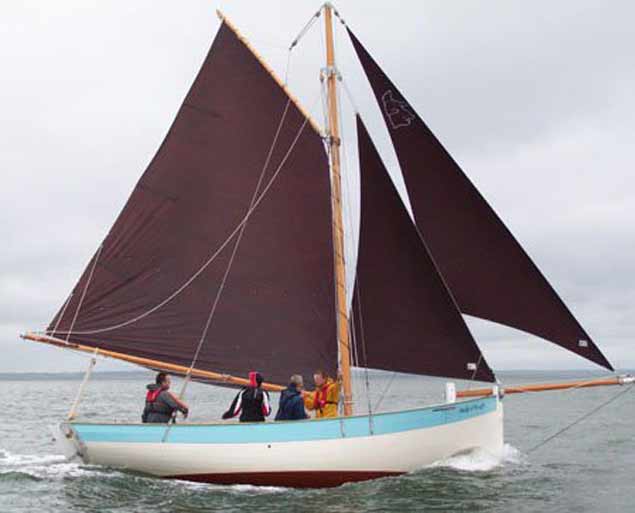 Community-built in Querrin on the Loop Head Peninsula, Sally O’Keeffe is a stylish design by Myles Stapleton.
Community-built in Querrin on the Loop Head Peninsula, Sally O’Keeffe is a stylish design by Myles Stapleton.
A Festive End to Foynes Sailing Season on the Shannon Estuary
Foynes Yacht Club on the Shannon Estuary finished on a high for the 2017 season just in time for Christmas with a festive theme for the final day of Sylver Refrigeration Open Dinghy November Series running every Sunday in the month. Organisers have been very lucky with the weather completing the full race programme of the Series which was preceded by an equally successful October Dinghy Series.
The club continues to be a hive of activity throughout the sailing season with dinghy racing opening the season in February and March and closing the season in October and November. In the summer months Cruiser Racing takes over with most of the dinghy sailors switching to a full calendar of events at club, regional and national level. Some of the cruiser fleet travelled far and wide with Big Deal competing at a number of international events, their best result winning the Dún Laoghaire to Dingle Double Handed Category, while the J24 Stouche was the first ever west coast boat to win their class the Irish Cruiser Racing National Championships in Cork.
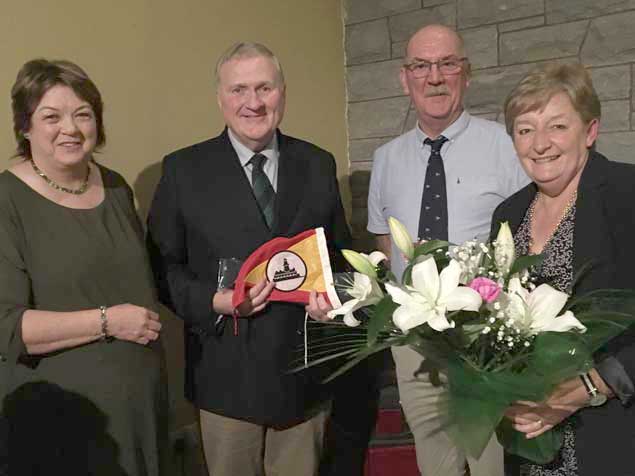 Irish Sailing President Jack Roy (second from left) is presented with the Foynes Yacht Club burgee by Commodore James McCormack. Also pictured are Patricia McCormack (left) and Rosemary Roy at the 2017 Laying–up supper
Irish Sailing President Jack Roy (second from left) is presented with the Foynes Yacht Club burgee by Commodore James McCormack. Also pictured are Patricia McCormack (left) and Rosemary Roy at the 2017 Laying–up supper
The Foynes Sailing Academy has gone from strength to strength with increasing numbers participating each year. FYC have invested year on year in safety equipment, boats and facilities and was described earlier this year by one of Irish Sailing’s Regional Development Officers as a Centre of Excellence. In 2017 the club’s sailing camps completely booked out and saw an increase in group bookings from school and scout groups. The Sailing Academy have placed a strong emphasis over the past few years in helping interested young sailors to follow the instructor pathway and this year for the first time all instructors that worked at the Academy were ‘home grown’.
At the recent Laying Up Supper of the club with over 130 in attendance Jack Roy, Irish Sailing President, spoke of the importance of volunteerism within the club structure. Commodore James McCormack paid tribute to the club members in particular the juniors who are doing the club so proud at club, local, regional, national and international level and to every member of the club throughout the year that have given their time freely for the benefit of the club.
The final instalment of the new pontoons built by the members will be in place next February, a magnificent achievement for the club, lead by James McCormack and John Joe Buckley and just in time for the start of a busy 2018 which will see the club host the Munster Mermaid Championships on the June 2nd/3rd, the J24 National Championships on June 8th to 10th and the Mermaid National Championships from August 2nd to 5th.
Shannon Estuary Adventure Tourism is Just a Stroke Away
Leisure rowers and adventure tourists could be enjoying the delights and challenges of the Shannon Estuary if a new wave of eco-adventure tourism is realised, writes Andrew Carey in Limerick.
That is according to Emmett O'Brien, the Pallaskenry native and local councillor who recently rowed a hand built Ilen Project gandelow over 20 miles from Ringmoylan Pier to Labasheda in West Clare.
The aim of the avid oarsman and Shannon Estuary enthusiast was to highlight the tourism potential that the Shannon Estuary has for communities on both sides of the water.
Forward thinking, planning and some cohesive work, according to Mr O'Brien, could "open up the waters to the growing industry of adventure tourism and guided rowing trips".
Cllr O'Brien was joined on the row by Mike Grimes from Coonagh and Tommy Roberts from Newtown, Clarina in what they described as a "fantastic experience to row along the Shannon estuary passing Beagh, Ballysteen, the Beeves lighthouse, the Fergus, Foynes Island and Killydysert".
Afterwards, Mr O'Brien who is a practicing barrister and local farmer said that "Limerick has a great opportunity to promote overseas adventure tourism on the Shannon estuary.
"In 2011 alone adventure tourism was worth €1.2m and the spend of activity tourism visitors is on average 45 per cent higher than ordinary overseas visitors.
"There is a huge opportunity to capitalise on chartered tours from the Limerick City and County side to any of hidden gems on the Shannon estuary.
"Our row showed us that, conceivably, subject to the right weather conditions and timing the tides accurately, adventure tourists could row from Limerick city to Loop Head in West Clare in just three days.
"Alternatively if they wanted a more prolonged adventure they could, over a week period, explore the attractions along the estuary such as Bunratty, Beeves lighthouse, the islands and monastic settlements on the Fergus and a whole host of villages on the estuary."
Recent studies from tourism bodies has shown that upwards of 100,000 international visitors travel to the UK and Ireland for rowing based holidays and tours during 2015 and 2016.
Cllr O'Brien believes that the Shannon Estuary can attract some of these visitors.
"In Limerick and Clare we have an untapped natural resource in the Shannon estuary from a tourism perspective and its high time the tourism officers of both councils looked at what it can deliver."
The J24 Western Championship weekend was characterised by great racing, sailing conditions and fantastic hospitality in Foynes Yacht Club.
The Championship - which saw boats from all around the island of Ireland take part - culminated in a great two final races in southerly breeze of 25 knots with gusts up to 30 knots.
Principal Race Officer Raymond McGibney chose Race Area Two and set a course east of Foynes Island.
The penultimate race got underway on schedule with JP McCaldin on Jamais Encore from Lough Erne / Sligo YC and Flor O’Driscoll, Hard on Port, from Royal Saint George Yacht Club duelling for the championship title. After a difficult first beat, only about 25% of the fleet flew spinnakers on the first downwind leg resulting in a big change in the leaders on that leg. In the testing conditions, Hard on Port fell outside the top three giving the title to the Lough Erne boat with one race to spare.
The last race of the day got underway with a clear start with the boats taking the right hand side of the course gaining at the top. Three rounds of the course were completed with the HYC K25 Team leading from the start to the finish followed in second place by Flor O’Driscoll, and Finbarr Ryan on Jelignite in third. Battles continued throughout the rest of the fleet with Jumpin Jive from Greystones YC representing the east coast on the podium in third place. After finishing the fleet sailed to the safe haven of FYC where all were quickly lifted from the water by BCS Crane Hire LTD.
 First place for the Jamais Encore crew from Lough Erne Yacht Club
First place for the Jamais Encore crew from Lough Erne Yacht Club
J/24 Class Association of Ireland President, Flor O’Driscoll, commented with delight about the rejuvenation in the J/24 fleet. This event had two newcomers to their regional events, the new HYC K25 Team on Scandal sailing a superb event and finishing first in the Silver Fleet, three points ahead of another newcomer Fergus Kelliher on Jibe from Tralee Bay Sailing Club. Third place went to Dave Lane & Sinéad Enright on YaGottaWanna from the Royal Cork Yacht Club.
The local contingent was led by Gala Racing from Foynes YC, coming in fifth in Gold & seventh place overall.
The prizegiving took place in the club with all competitors in attendance. Sponsors Yachtsman Euromarine, UK McWilliam Sailmakers, North Sails, Quantum Sails, BCS Crane Hire LTD and Cliffords Cash and Carry were thanked. A special thanks went to the members of FYC for all their help over the weekend.
Yachtsman Euromarine J24 Western Championships Overall -
Gold Fleet
1st IRL5278 Jamais Encore JP. McCaldin Lough Erne / Sligo Yacht Club
2nd IRL4794 Hard on Port F. O'Driscoll Royal St. George Yacht Club
3rd IRL3060 Jumpin Jive M. Usher Greystones Sailing Club
Sliver Fleet
1st IRL4212 Scandal HYC K25 Team Howth Yacht Club
2nd IRL4252 Jibe F. Kelliher Tralee Bay Sailing Club
3rd IRL5098 Ya Gotta Wanna D. Lane / S. Enright Royal Cork Yacht Club
Day one of the Yachtsman Euromarine J24 West Coast Championships at Foynes Yacht Club dawned to overcast skies with a westerly force 8-10 knots of breeze writes Elaine O'Mahoney. Last minute tweaking on the pontoon was followed by a procession of J/24’s out of the main channel. Race area one, west of the club house was chosen, which paid dividend for anyone travelling the coast road during the races as they were sailing close to the shore at Mount Trenchard which made for a spectacular sight between Foynes and Glin.
“The first Championships of the 2017 for the Irish J/24 fleet showed a high level of skill from the teams, matched by a very competitive spirit. The racing was physical but fun with new J/24 crew (press ganged at the last minute) getting a baptism of fire. The close racing, typical of the class, gave the newcomers an experience they will remember for some time. The fourteen year old on our boat didn’t know racing could be so scary and fun at the same time. I think we have a new convert! The future of the J/24 is looking good!”
Finbarr Ryan of LRYC/HYC
“Race one, after battling with the pin end, the fleet headed left up the beat, hugging the shore, which led to several port-starboard incidents across the fleet. Both windward marks were incident-rich, with many suffering from tide and port raiders.
Race two Hard on Port nailed the pin end, hugged the shore, and led from start to finish, oblivious to the battles going on astern. A similar format at the front followed for race three.
In race four, with an ebbing tide, eager beavers led to a general recall. Hard on Port was taken out at the start, leaving Jelignite, Scandal and Jamais Encore in a battle up the first beat. With the breeze shifting right and the tide having turned, the right side of the course was favoured, catching much of the fleet off guard after the swelling flood tide. More pressure and an early gybe allowed Jamais to move from third to first & dominated the rest of the race to take the bullet.
All the fleet were met with a pontoon beer reception which was a perfect finish to a great day’s sailing.”
Jeff Harrison of LEYC
The night finished off with over one hundred sailors sitting down for the championship dinner followed by a live band.
The day’s racing concluded with Jamais Encore, JP McCaldin from LEYC leading from Hard on Port, Flor O’Driscoll RStGYC in the Gold Fleet and in third place Mark Usher on Jumpin Jive from Greystones Sailing Club.
The Silver Fleet is all tied with HYC U25 Keelboat Team joint first with Fergus Kelliher on Jibe from Tralee Bay Sailing Club, with YaGottaWanna, Sinéad Enright and Dave Lane from RCYC in third.
Full racing results here
Eighty five sailors from around Ireland have gathered in Limerick with all province’s being represented at the two day Yachtsman Euromarine J/24 Western Championships. Looking east from the Foynes Yacht Club clubhouse the sixteen J/24’s gently move tied to the club’s new pontoon.
Crews were welcomed by their host with a complimentary bottle of beer/soft drink supplied by Gala Supermarkets. BCS Crane Hire LTD. made short work of lifting the boats in. The breakdown of the Gold and Silver Fleets has been made and can be found here.
“After the three hour drive - the smooth operation of the crane and the welcoming committee were second to none & rumour has it the Guinness is good in the clubhouse. Looking forward to the racing”, commented Harry Cronin of the K25 Team from Howth Yacht Club.
Proceedings get underway with a briefing at 0930hrs followed by First Gun at 1130 with four races scheduled on day one.
A report of day one’s racing & results will follow
A training exercise testing the response capabilities of Shannon Foynes Port Company, local authorities and other organisations who operate in the vicinity of the Shannon Estuary will take place at Spanish Point, County Clare, on Wednesday and Thursday of next week (26-27 April).
The simulated event, which is being hosted by Clare County Council on behalf of the Shannon Estuary Anti-Pollution Team (SEA-PT), will centre on a major spillage of crude oil having occurred from an oil exploration platform located approximately 220km off the south west coast of Ireland and oil coming ashore at Spanish Point.
Other parameters for the exercise will include notification that the source of the pollution has been brought under control and that there have been no casualties on the oil exploration platform.
There will be a practical element on site at Spanish Point involving operation and demonstration of equipment while a technical briefing will be carried out on equipment on site for officials. The second day of the event will consist of the management of a simulated large scale event for senior management of Local Authorities, SEA-PT members and the Coastguard in Clare County Council’s headquarters at Áras Contae an Chláir, Ennis, which will act as the Incident Command Centre.
“Spill simulations are an excellent way to exercise and train personnel in their emergency roles and to test contingency plans and procedures,” explained John Leahy, Senior Engineer, Clare County Council.
“Valuable lessons can be learned from such exercises, which include a variety of participants, such as oil spill management teams, field responders and regulators and community members. Participants will work together in conducting a simulated response to this hypothetical incident in order to demonstrate proficiency and validity of the oil pollution response plan which is in place for Clare,” he said.
Clare County Council has advised that the training event will not be open to the public while the northern end of the public carpark will be closed off to the public on 25th and 26th April. Public access to Spanish Point beach will be maintained throughout the exercise.






























